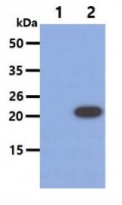ARG56945
anti-CIB1 antibody [1D1]
anti-CIB1 antibody [1D1] for Western blot and Human
Overview
| Product Description | Mouse Monoclonal antibody [1D1] recognizes CIB1 |
|---|---|
| Tested Reactivity | Hu |
| Tested Application | WB |
| Host | Mouse |
| Clonality | Monoclonal |
| Clone | 1D1 |
| Isotype | IgG2b, kappa |
| Target Name | CIB1 |
| Antigen Species | Human |
| Immunogen | Recombinant fragment around aa. 1-191 of Human CIB1. |
| Conjugation | Un-conjugated |
| Alternate Names | CIB; Calcium- and integrin-binding protein; Calmyrin; Kinase-interacting protein; KIP; CIBP; KIP1; PRKDCIP; Calcium and integrin-binding protein 1; SNK-interacting protein 2-28; SIP2-28; DNA-PKcs-interacting protein |
Application Instructions
| Application Suggestion |
|
||||
|---|---|---|---|---|---|
| Application Note | * The dilutions indicate recommended starting dilutions and the optimal dilutions or concentrations should be determined by the scientist. |
Properties
| Form | Liquid |
|---|---|
| Purification | Purification with Protein G. |
| Buffer | PBS (pH 7.4), 0.02% Sodium azide and 10% Glycerol. |
| Preservative | 0.02% Sodium azide |
| Stabilizer | 10% Glycerol |
| Concentration | 1 mg/ml |
| Storage Instruction | For continuous use, store undiluted antibody at 2-8°C for up to a week. For long-term storage, aliquot and store at -20°C. Storage in frost free freezers is not recommended. Avoid repeated freeze/thaw cycles. Suggest spin the vial prior to opening. The antibody solution should be gently mixed before use. |
| Note | For laboratory research only, not for drug, diagnostic or other use. |
Bioinformation
| Database Links |
Swiss-port # Q99828 Human Calcium and integrin-binding protein 1 |
|---|---|
| Gene Symbol | CIB1 |
| Gene Full Name | calcium and integrin binding 1 (calmyrin) |
| Background | This gene encodes a member of the EF-hand domain-containing calcium-binding superfamily. The encoded protein interacts with many other proteins, including the platelet integrin alpha-IIb-beta-3, DNA-dependent protein kinase, presenilin-2, focal adhesion kinase, p21 activated kinase, and protein kinase D. The encoded protein may be involved in cell survival and proliferation, and is associated with several disease states including cancer and Alzheimer's disease. Alternative splicing results in multiple transcript variants. [provided by RefSeq, Apr 2013] |
| Function | Calcium-binding protein that plays a role in the regulation of numerous cellular processes, such as cell differentiation, cell division, cell proliferation, cell migration, thrombosis, angiogenesis, cardiac hypertrophy and apoptosis. Involved in bone marrow megakaryocyte differentiation by negatively regulating thrombopoietin-mediated signaling pathway. Participates in the endomitotic cell cycle of megakaryocyte, a form of mitosis in which both karyokinesis and cytokinesis are interrupted. Plays a role in integrin signaling by negatively regulating alpha-IIb/beta3 activation in thrombin-stimulated megakaryocytes preventing platelet aggregation. Up-regulates PTK2/FAK1 activity, and is also needed for the recruitment of PTK2/FAK1 to focal adhesions; it thus appears to play an important role in focal adhesion formation. Positively regulates cell migration on fibronectin in a CDC42-dependent manner, the effect being negatively regulated by PAK1. Functions as a negative regulator of stress activated MAP kinase (MAPK) signaling pathways. Down-regulates inositol 1,4,5-trisphosphate receptor-dependent calcium signaling. Involved in sphingosine kinase SPHK1 translocation to the plasma membrane in a N-myristoylation-dependent manner preventing TNF-alpha-induced apoptosis. Regulates serine/threonine-protein kinase PLK3 activity for proper completion of cell division progression. Plays a role in microtubule (MT) dynamics during neuronal development; disrupts the MT depolymerization activity of STMN2 attenuating NGF-induced neurite outgrowth and the MT reorganization at the edge of lamellipodia. Promotes cardiomyocyte hypertrophy via activation of the calcineurin/NFAT signaling pathway. Stimulates calcineurin PPP3R1 activity by mediating its anchoring to the sarcolemma. In ischemia-induced (pathological or adaptive) angiogenesis, stimulates endothelial cell proliferation, migration and microvessel formation by activating the PAK1 and ERK1/ERK2 signaling pathway. Promotes also cancer cell survival and proliferation. May regulate cell cycle and differentiation of spermatogenic germ cells, and/or differentiation of supporting Sertoli cells. Isoform 2: Plays a regulatory role in angiogenesis and tumor growth by mediating PKD/PRKD2-induced vascular endothelial growth factor A (VEGFA) secretion. [UniProt] |
| Calculated MW | 22 kDa |
| PTM | Phosphorylation of isoform 2 at Ser-118 by PRKD2 increases its ability to stimulate tumor angiogenesis. |
Images (2) Click the Picture to Zoom In
-
ARG56945 anti-CIB1 antibody [1D1] WB image
Western blot: 40 µg of HT29 stained with ARG56945 anti-CIB1 antibody [1D1] at 1:1000.
-
ARG56945 anti-CIB1 antibody [1D1] WB image
Western blot: 10 µg of 1) 293T cell lysate, 2) CIB1 Transfected 293T cell lysate stained with ARG56945 anti-CIB1 antibody [1D1] at 1:1000. .







